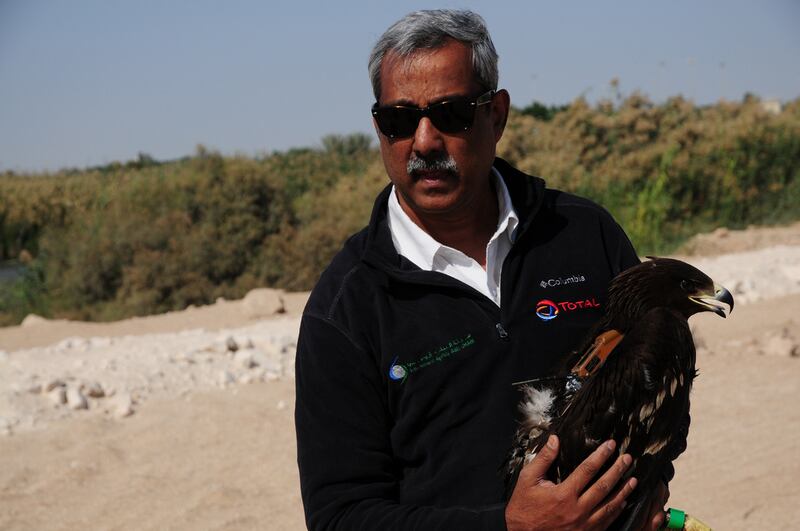ABU DHABI // Having been suspected of migrating far beyond what scientists previously thought, the sooty falcon is beginning to tell animal conservationists the story of its perilous 6,700-kilometre journey after being tagged by the Environment Agency Abu Dhabi.
The falcon, nicknamed Ibn Battuta by scientists at the EAD, after the legendary Arab traveller, was tagged with a solar-powered GPS device in 2009 and has since then been relaying information to conservationists around the world.
“People had a hunch that this bird went south but, until we put a tracking device on it, no one could be sure,” said Dr Salim Javed, EAD’s acting director of terrestrial biodiversity. “The sooty falcon is one of the birds that we were the first to tag.”
The falcon surprised scientists when they found out it would migrate all the way to Madagascar, making stops in Ethiopia, Kenya and Tanzania. But perhaps more surprising was the landscape in which they found the bird spending a lot of its time.
The GPS showed researchers that the bird made several extended stops in fields used for commercial crops – stopping long enough for scientists to think that the bird had died.
“It was surprising to see them stop in agricultural grounds, and that made us realise that spending that much time there could expose the birds to all kinds of pesticides,” Dr Javed said. “This is the kind of completely new information that GPS tracking adds to our knowledge, adds to our attempts at conservation of these species and these habitats.”
A greater spotted eagle tagged in Abu Dhabi last year this week reached Russia. The bird was tagged in Al Wathba Wetland Reserve in Abu Dhabi and reached southern Russia on April 24 as part of its spring migration.
“The birds we track depend on what questions you want answers to, so when we started we wanted to know the movement and migration of flamingos,” said Dr Javed, referring to the project launch in 2005.
“We now track ostrich, eagles, sooty falcons, water birds; some of these species have been tagged for the very first time in the world, so we are trying to take the lead in those projects.”
Tagging the birds, he said, was also quite elaborate. The GPS device must be ordered according to the bird they intend to tag, because it cannot weigh more than 3 per cent the bird’s weight. After the bird is caught in a trap, the EAD team attaches the tracking device in a fashion “very similar to pupils wearing backpacks”.
More than 460 species of birds have been recorded in the country, more than 75 per cent of which are migratory.
There are two distinct categories of migration. First, there are birds that come here during winter months, largely from Europe and Central Asia, to spend winter or to stop over en route to wintering areas in Africa. The other type includes summer breeding birds, largely seabirds, which come from the Indian Ocean to breed. These two groups mean the bird calendar is busy throughout the year.
“Migratory birds are faced with many challenges, ranging from habitat loss, hunting, illegal killing or taking, poisoning and electrocution. Rapidly changing landscapes, urban and industrial expansion, particularly in coastal areas, makes not only migratory but also resident birds highly vulnerable,” said Dr Shaikha Al Dhaheri, EAD’s executive director for terrestrial and marine biodiversity.
Dr Al Dhaheri said that protecting migratory birds and ensuring environments conducive to their reproduction and safe migration was “not an option but a necessity”.
She said that strong cooperation between the emirates and both government and non-profit organisations was key in achieving it.
nalwasmi@thenational.ae





